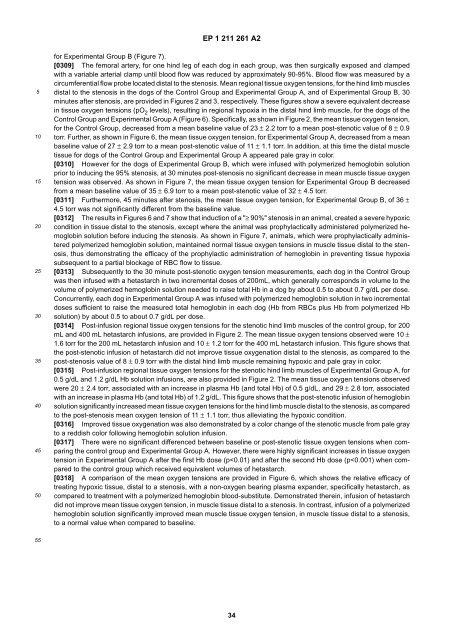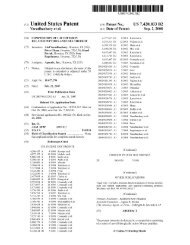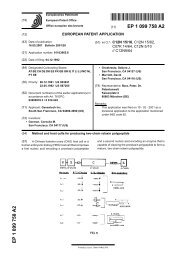EP 1 211 261 A2
EP 1 211 261 A2
EP 1 211 261 A2
You also want an ePaper? Increase the reach of your titles
YUMPU automatically turns print PDFs into web optimized ePapers that Google loves.
<strong>EP</strong> 1 <strong>211</strong> <strong>261</strong> <strong>A2</strong>5101520253035404550for Experimental Group B (Figure 7).[0309] The femoral artery, for one hind leg of each dog in each group, was then surgically exposed and clampedwith a variable arterial clamp until blood flow was reduced by approximately 90-95%. Blood flow was measured by acircumferential flow probe located distal to the stenosis. Mean regional tissue oxygen tensions, for the hind limb musclesdistal to the stenosis in the dogs of the Control Group and Experimental Group A, and of Experimental Group B, 30minutes after stenosis, are provided in Figures 2 and 3, respectively. These figures show a severe equivalent decreasein tissue oxygen tensions (pO 2 levels), resulting in regional hypoxia in the distal hind limb muscle, for the dogs of theControl Group and Experimental Group A (Figure 6). Specifically, as shown in Figure 2, the mean tissue oxygen tension,for the Control Group, decreased from a mean baseline value of 23 ± 2.2 torr to a mean post-stenotic value of 8 ± 0.9torr. Further, as shown in Figure 6, the mean tissue oxygen tension, for Experimental Group A, decreased from a meanbaseline value of 27 ± 2.9 torr to a mean post-stenotic value of 11 ± 1.1 torr. In addition, at this time the distal muscletissue for dogs of the Control Group and Experimental Group A appeared pale gray in color.[0310] However for the dogs of Experimental Group B, which were infused with polymerized hemoglobin solutionprior to inducing the 95% stenosis, at 30 minutes post-stenosis no significant decrease in mean muscle tissue oxygentension was observed. As shown in Figure 7, the mean tissue oxygen tension for Experimental Group B decreasedfrom a mean baseline value of 35 ± 6.9 torr to a mean post-stenotic value of 32 ± 4.5 torr.[0311] Furthermore, 45 minutes after stenosis, the mean tissue oxygen tension, for Experimental Group B, of 36 ±4.5 torr was not significantly different from the baseline value.[0312] The results in Figures 6 and 7 show that induction of a "≥ 90%" stenosis in an animal, created a severe hypoxiccondition in tissue distal to the stenosis, except where the animal was prophylactically administered polymerized hemoglobinsolution before inducing the stenosis. As shown in Figure 7, animals, which were prophylactically administeredpolymerized hemoglobin solution, maintained normal tissue oxygen tensions in muscle tissue distal to the stenosis,thus demonstrating the efficacy of the prophylactic administration of hemoglobin in preventing tissue hypoxiasubsequent to a partial blockage of RBC flow to tissue.[0313] Subsequently to the 30 minute post-stenotic oxygen tension measurements, each dog in the Control Groupwas then infused with a hetastarch in two incremental doses of 200mL, which generally corresponds in volume to thevolume of polymerized hemoglobin solution needed to raise total Hb in a dog by about 0.5 to about 0.7 g/dL per dose.Concurrently, each dog in Experimental Group A was infused with polymerized hemoglobin solution in two incrementaldoses sufficient to raise the measured total hemoglobin in each dog (Hb from RBCs plus Hb from polymerized Hbsolution) by about 0.5 to about 0.7 g/dL per dose.[0314] Post-infusion regional tissue oxygen tensions for the stenotic hind limb muscles of the control group, for 200mL and 400 mL hetastarch infusions, are provided in Figure 2. The mean tissue oxygen tensions observed were 10 ±1.6 torr for the 200 mL hetastarch infusion and 10 ± 1.2 torr for the 400 mL hetastarch infusion. This figure shows thatthe post-stenotic infusion of hetastarch did not improve tissue oxygenation distal to the stenosis, as compared to thepost-stenosis value of 8 ± 0.9 torr with the distal hind limb muscle remaining hypoxic and pale gray in color.[0315] Post-infusion regional tissue oxygen tensions for the stenotic hind limb muscles of Experimental Group A, for0.5 g/dL and 1.2 g/dL Hb solution infusions, are also provided in Figure 2. The mean tissue oxygen tensions observedwere 20 ± 2.4 torr, associated with an increase in plasma Hb (and total Hb) of 0.5 g/dL, and 29 ± 2.8 torr, associatedwith an increase in plasma Hb (and total Hb) of 1.2 g/dL. This figure shows that the post-stenotic infusion of hemoglobinsolution significantly increased mean tissue oxygen tensions for the hind limb muscle distal to the stenosis, as comparedto the post-stenosis mean oxygen tension of 11 ± 1.1 torr, thus alleviating the hypoxic condition.[0316] Improved tissue oxygenation was also demonstrated by a color change of the stenotic muscle from pale grayto a reddish color following hemoglobin solution infusion.[0317] There were no significant differenced between baseline or post-stenotic tissue oxygen tensions when comparingthe control group and Experimental Group A. However, there were highly significant increases in tissue oxygentension in Experimental Group A after the first Hb dose (p




